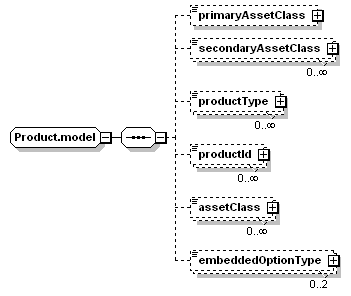
Namespace: |
|
Content: |
6 elements |
Defined: |
globally in fpml-shared-5-3.xsd; see XML source |
Includes: |
definitions of 6 elements |
Used: |
at 1 location |

Complex Content Model |
| primaryAssetClass?, secondaryAssetClass*, productType*, productId*, assetClass*, embeddedOptionType[0..2] |
| assetClass, | productId (defined in Product.model group), |
| <xsd:group name="Product.model"> <xsd:sequence> <!-- end BAL 2011-02-20 --> <xsd:element fpml-annotation:deprecated="true" fpml-annotation:deprecatedReason="This element has been moved to before productType" maxOccurs="unbounded" minOccurs="0" name="assetClass" type="AssetClass"/> </xsd:sequence> </xsd:group> |
Type: |
AssetClass, simple content |
| xsd:normalizedString |
maxLength: |
255 |
| <xsd:element fpml-annotation:deprecated="true" fpml-annotation:deprecatedReason="This element has been moved to before productType" maxOccurs="unbounded" minOccurs="0" name="assetClass" type="AssetClass"/> |
Type: |
EmbeddedOptionType, simple content |
| xsd:normalizedString |
maxLength: |
255 |
| <xsd:element maxOccurs="2" minOccurs="0" name="embeddedOptionType" type="EmbeddedOptionType"/> |
Type: |
AssetClass, simple content |
| xsd:normalizedString |
maxLength: |
255 |
| <xsd:element minOccurs="0" name="primaryAssetClass" type="AssetClass"/> |
Type: |
ProductId, simple content |
| xsd:normalizedString |
maxLength: |
255 |
Type: |
ProductType, simple content |
| xsd:normalizedString |
maxLength: |
255 |
| <xsd:element maxOccurs="unbounded" minOccurs="0" name="productType" type="ProductType"/> |
Type: |
AssetClass, simple content |
| xsd:normalizedString |
maxLength: |
255 |
| <xsd:element maxOccurs="unbounded" minOccurs="0" name="secondaryAssetClass" type="AssetClass"/> |
| XML schema documentation generated with DocFlex/XML 1.8.6b2 using DocFlex/XML XSDDoc 2.5.1 template set. All content model diagrams generated by Altova XMLSpy via DocFlex/XML XMLSpy Integration. |